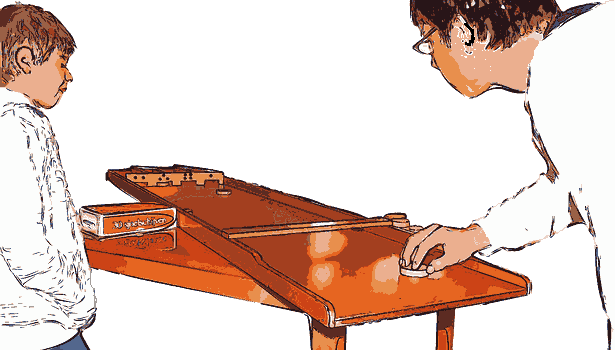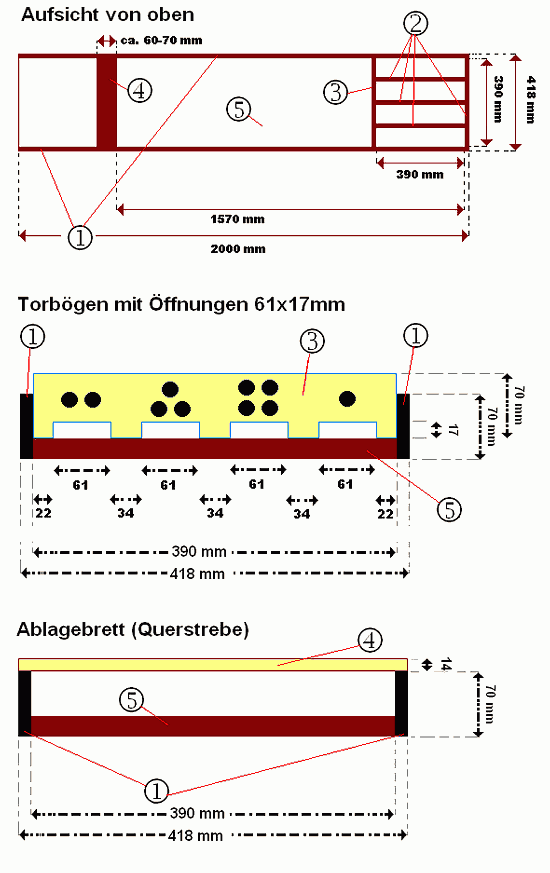source: www.youthwork-practice.com | 2000 Games, Devotions, Themes, Ideas and more for Youth Work
only for private using
Shuffleboard

| Age: | 14+ |
| Materials: | MDF sheet, wooden slats, screws, glue, screws clamps, jigsaw without scroll saw, sand paper. |
| Summary: | Make a shuffle board yourself; using it to play in tournaments. |
Description:
Jakkolo (Dutch Shuffleboard)
Or as is said in France: Billard Hollandais
JAKKOLO is a brilliant party game and is well suited for children, students or youth work. Either as a casual game or as an evening event, this game can thrill the entire group. The Jakkolo games board is easy to store behind a door or in the broom cupboard – it doesn’t take up much space.
The game board currently costs between 130-150 Euros and can be obtained e.g. through AMAZON. Whoever is somewhat skilled can also try and make the board themselves. I have written building instructions below.
Game rules
There are 3 rounds. In the first round, a player attempts to shoot the 30 games-pieces into the available 4 openings. In this round the discs are flicked, pushed or shot underneath the horizontal bar (stacker beam). All the games-pieces are played. It is almost impossible to shoot all of the pieces into the four openings. There are always some pieces that remain on the board in front of the openings hence blocking any other pieces from getting through. The following games pieces are pushed in a way similar to Billiards, to get them through the holes (From this the name “Billard Hollandais”). After all the pieces have been played, any of the pieces that disappeared without going through one of the 4 openings, are used for the second round. Similarly if there are pieces that remain at the end of the 2nd round they can be used for a third and final round. After the 3rd round, points are calculated and the score determined.
Point determination
If a disc is lying in each field, it counts as 20 points. Per “set” 20 points are always calculated (e.g. if there are 4 discs in each field 80 points are given in total). For each incomplete set, the value of each respective disc for a field is added (the points lie in front of the respective goals). The maximum number of points is 148, this means that in the 3 rounds all 30 games pieces are equally and successfully ‘sunk’ (7 stones respectively in the 4 openings = 28 stones giving 148 points), as well as 2 additional pieces shot into goal 4 (2x4 = 8 points).
Simplified rules
Depending on participant numbers, you can play this differently as naturally each person wants a turn. One player receives 15 pieces, which they consecutively try to shoot under the horizontal bars and into one of the 4 goals. Once all 15 pieces have been played the points are to follow. There is no 2nd or 3rd round. The point determination is as described above. This means that per set the player receives 20 points, and for each additional stone, the points for the respective field. With this variation it is often the case that for some fields not a single games piece has been shot through the goal. As a result a simple addition of points is possible without adding any bonus points. Consequently this variation is quicker to play and after the point determination, it is the next persons turn to play. After each player has had at turn, further rounds can follow to improve on one’s score.

Illustrations
Image:
No. 1 = Side Strips
No. 2 = Divider strips
No. 3 = Goal arches
No. 4 = Horizontal bar (stacker beam)
No. 5 = Base plate (smooth surface is very important)
The measurements are not quite the original measurements for tournaments. The size of the goal opening is 60x17mm for tournaments. The width of the pitch from wall to wall is 386mm. If someone does not wish to use the precise measurements, then they should measure 386 mm instead of 390 mm. The goal opening should be set up with a width of 60mm. All the other measurements are the same and apply.
Building instructions
A Jakkolo games board can be made with a little skill. Especially for youth groups, 130 Euros are not always part of the budget to be able to afford a game like this. What is the important thing when choosing the wood? The surface of the wood has to be very smooth, so that the games pieces slide well. This means that an ordinary pine-wood board is probably not suitable. MDF boards are well suited and cheap – available to buy at hardware stores. Kitchen work tops could also work, however they are too heavy.
Materials needed:
- Base plate: 2000mm long, 390mm wide (see illustration no.5: MDF sheet, or other board with very smooth surface, the thickness of the sheet should be approximately 14-25mm )
- 2 wooden strips 14mm thick, 65 – 70mm high, and 2000mm length (see illustration no. 1 )
- 5 strips: 14mm thick, 65 – 70mm high, and 390mm long (see illustration no. 2 and 3)
- 1 strip: 14mm thick, 65 – 70 mm high and 418mm long (see illustration no. 4)
Use glue or a small screw – length approximately 20mm, to attach the wooden strips to one another. Use the jig saw / scroll saw to make the goal-openings. Sanding machine and sand paper to round off the wooden edges. Screw clamps or screwdriver to attach the wooden parts to one another.
Putting together the individual wooden parts is unthinkably simple. Firstly the wooden pieces are sawn to the correct lengths. The piece of wood with the goal-opening is made. All the pieces are then loosely placed together to ensure that all the parts fit. Followed by assembling (gluing and screwing together). Either prior or after putting together all the pieces, round off the corners to avoid any sharp corners that could cause injury.
The Game-discs
The Jakkolo discs have the following measurements: 52mm width, 3mm height, and weight of approximately 20grams. In principle they look like larger variations of the pieces used for Draughts or ‘Nine Mens’ Morris’. With a little skill the discs can be sawn using a key-hole saw, and then sanded smooth with sand paper.
[ © www.youthwork-practice.com | 2000 Games and Ideas for Youth Work ]






